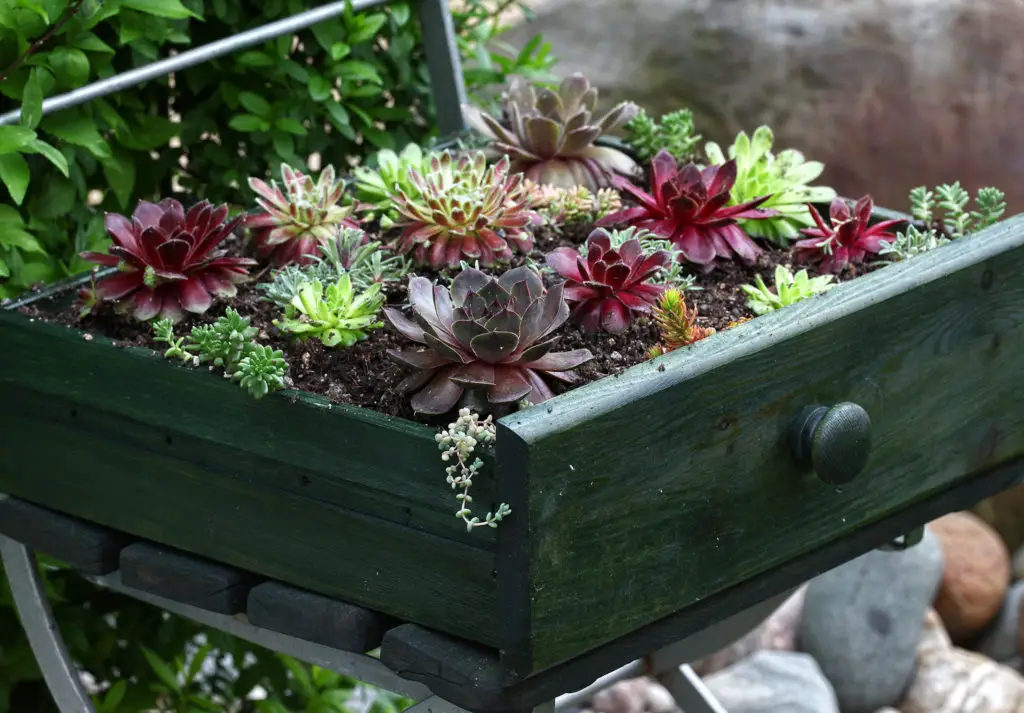
Saucers are great for keeping your furniture and floors dry when watering your plants. They also have an aesthetic appeal, especially if it comes as a matching set with your pot. But what about outdoor potted plants?
Saucers aren’t a must for outdoor potted plants, spills aren’t as much of a concern on concrete or dirt. You should still use pot risers or pot feet to prevent blocking the drain on the bottom of the pot. Keep in mind, spills on wooden decks or furniture may cause wood discoloration and rot over time if no saucer is used.
Below, I elaborate more on using saucers in general, along with alternative options:
(As an Amazon Associate, I earn from qualifying purchases.)
Table of contents
What Are The Purposes of a Plant Saucer?

Here are three main reasons why people use plant saucers:
- It collects excess dirty water draining from the pot. You obviously don’t want water and runaway soil staining your coffee table and varnished floors. That’s your pet’s job, not the plant’s. Opting for a decorative pot with no drain holes is a good alternative, but ensure to empty excess water afterward.
- It acts as a reservoir for bottom watering. The soil wicks up the water through the drain holes, effectively saturating as much as the plant only needs. If you’d like to know more about top and bottom watering, you can read about it in this article.
- It can be repurposed as a makeshift pebble tray to increase humidity levels. All it requires is adding a pebble layer with enough water to cover the bottom of the saucer. The water evaporates around the plant, improving its surrounding humidity. And the stones elevate the plant to prevent oversaturating the soil.
Important note: Rinse saucers weekly to avoid mineral salt from accumulating. These salt deposits can burn the roots if you’re used to bottom watering your plant. They typically come from fertilizer salts flushed out of the soil or hard tap water.
Apart from that, you can always get a saucer purely for aesthetic reasons, but it does have its functional purposes. Even if they don’t come as a set with your pot, you can always buy them separately and do a little mix and match.
What alternatives can I use instead of plant saucers?
Any dish can be a makeshift saucer for a potted plant, provided it’s not flat. If you’re using it only for elevation, it’s okay. But it’s safer to use a dish with at least an inch of depth. Otherwise, you risk accumulated water overflowing.
Does My Planter Need a Saucer at the Bottom?

Your indoor planters are better off with saucers to contain any watery mess in your living space. Just be sure to discard any surplus water in the saucer. Standing water can still be sucked up by the plant, waterlogging the soil or even become a breeding ground for mosquitoes. You can read about how indoor plants can attract mosquitoes in this article.
As for outdoor planters, it depends but generally, you don’t need them. But here are two scenarios in which it’s beneficial to have saucers for an outdoor plant:
- The potted plant is on wooden: furniture, decks, porches, railings, or steps. Even if the deck is coated with a sealant, these can get stripped over time if moisture keeps pooling in the same area. A saucer will keep water off of the wood and extends any wooden structure’s life.
- The potted plant isn’t releasing any excess moisture and seems over watered or is suffering from root rot. This could mean that the ground has sealed completely with the bottom of the pot, waterlogging the soil. A saucer or any elevated structure can prevent this.
Important note: Do not purchase a pot with a permanently attached saucer. It’s nothing but a hassle, removing standing water means tipping the whole plant and pot, it can get heavy with bigger plants.
What Else Can You Put Under Outdoor Pots?

Any simple elevated structures such as pot risers or pot feet are good options to place underneath outdoor planters. More often than not, these are used for a singular functional purpose – to allow free-flow drainage from the pot although, they make for great decoration.
You don’t necessarily need expensive pot risers or pot feet (Amazon links) for this. You can use bottle lids, thin cut-up PVC pipe, bricks, cinder blocks, or even pieces of broken tiles. Basically, utilize whatever you have at home to heighten your outdoor pots.
Why Do Plant Pots Need Feet?
Pot feet help elevate planters and prevent drainage blockage. Copper-made ones are also known to be effective in keeping slugs and snails from infesting potted plants. They are also just nice to look at.
Final Words
Overall, using saucers for your outdoor potted plants is more of a personal choice than a hard and fast rule. Consider saucers for protecting your wooden decks and furniture but, feel free to skip the saucer if what the pot is on doesn’t need protection. Just make sure the pot is elevated so water can drain out! 😀 Happy planting!
References:
https://news.extension.uconn.edu/2013/12/24/watering-houseplants/
https://content.ces.ncsu.edu/extension-gardener-handbook/18-plants-grown-in-containers
https://www.aces.edu/blog/topics/landscaping/container-gardening/
https://web.extension.illinois.edu/containergardening/choosing_drainage.cfm





